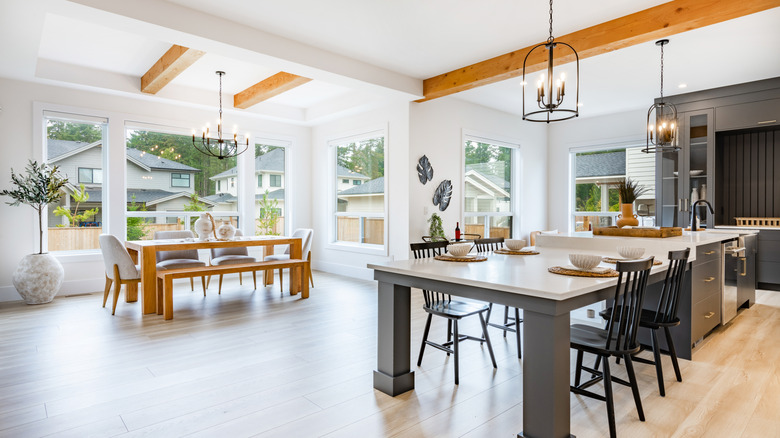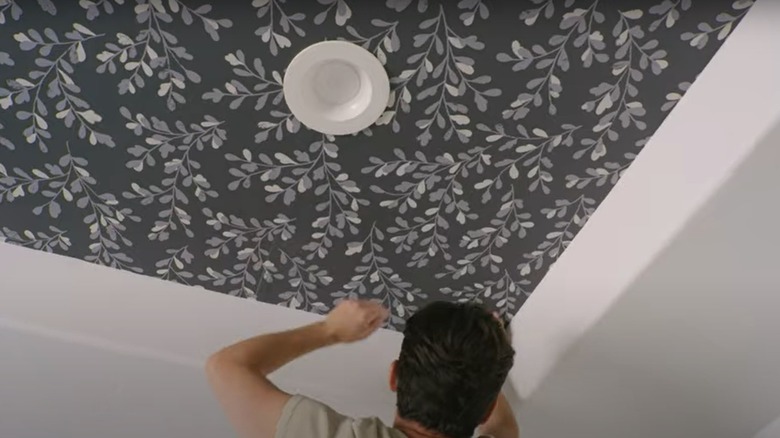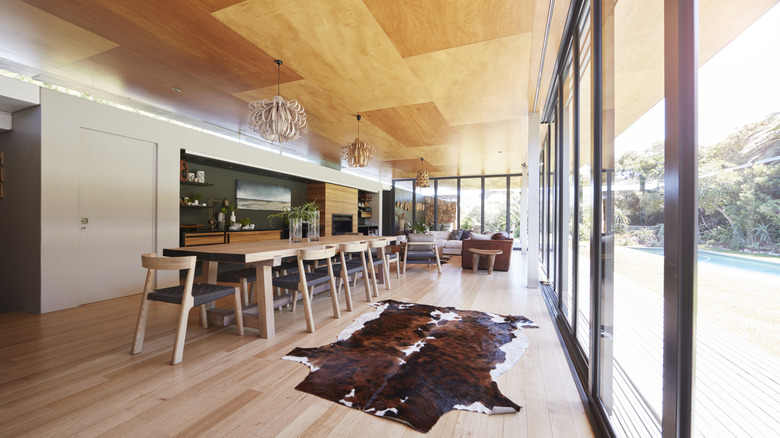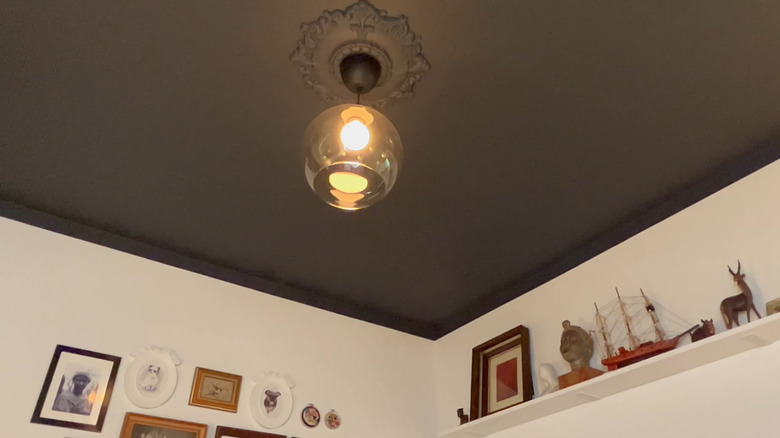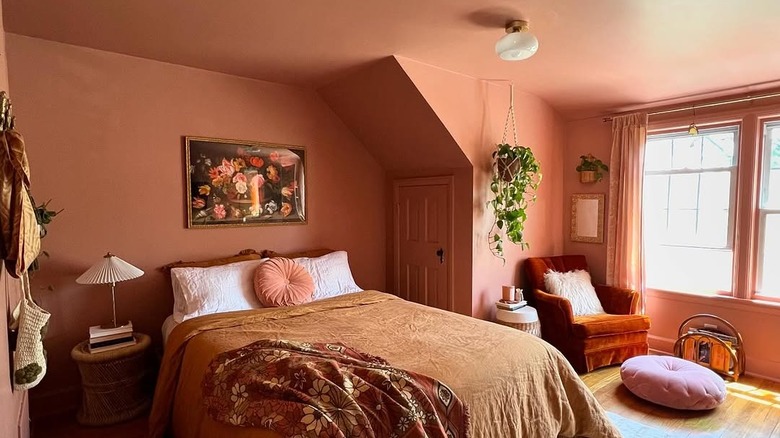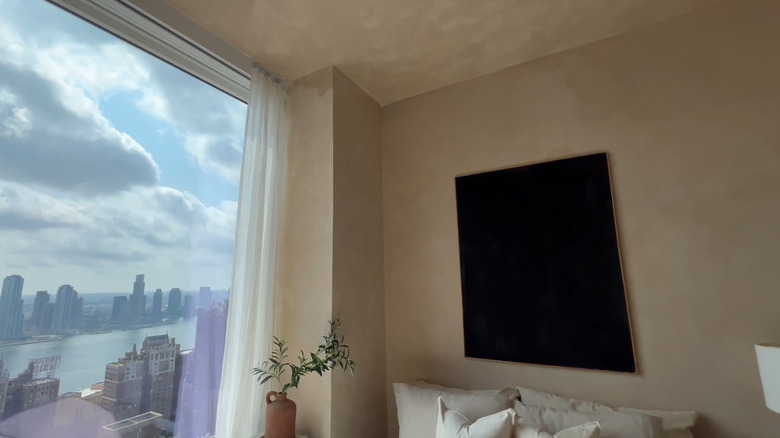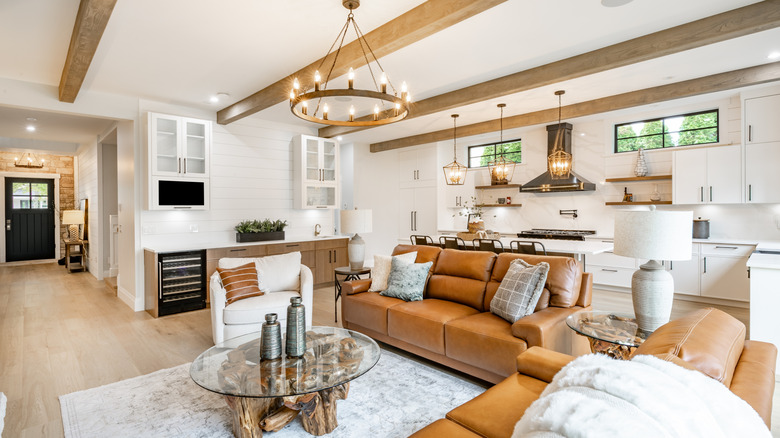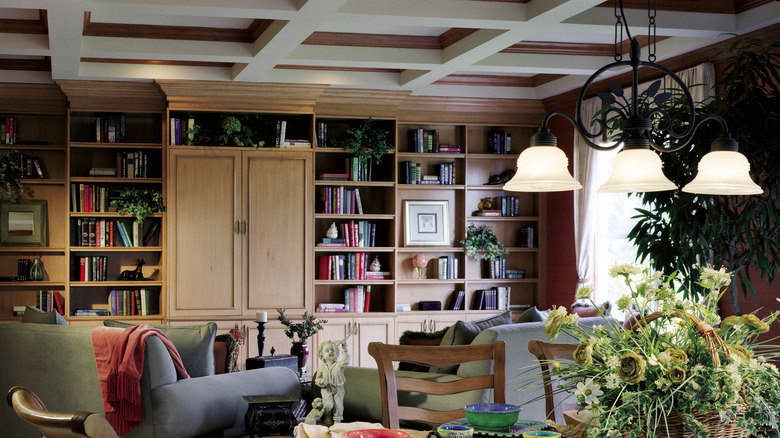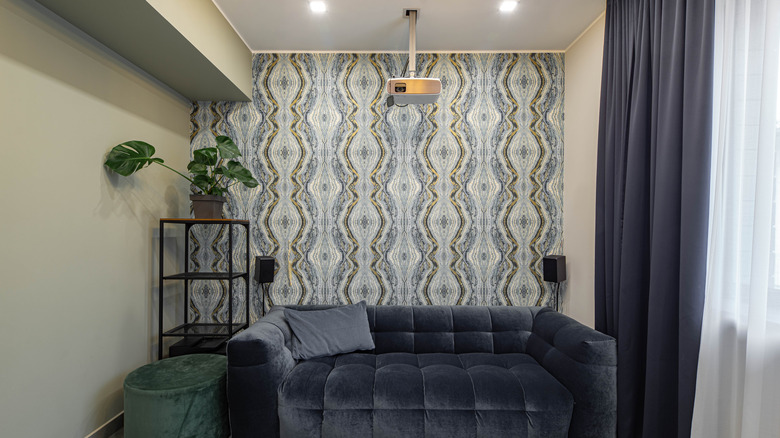Top Ceiling Trends You Can Expect To See More Of In 2025
We may receive a commission on purchases made from links.
As the pages of the calendar turn, so too do design trends. The world of interior design is constantly evolving. What was popular a few years ago might be on its way out, making room for new and exciting design ideas. If you're looking to upgrade your living space, it is natural to think about the furniture, wall color, and any decorative pieces. But, you shouldn't overlook your ceiling as it's a (literally) large part of your space. And, if used correctly, it can really help contribute to your overall design goals.
We reached out to four interior design experts to learn more about the ceiling trends that we should expect to see more of in 2025. During their exclusive interviews, each of these experts shared their thoughts on some interesting and exciting trends that may take over the design world in the coming months. These are the insights that they shared as well as some tips for upgrading your own home's ceiling.
Wallpapered ceilings create a bold statement
Wallpaper may traditionally be applied to vertical walls, but that's not the only flat surface that can benefit from the look. During an exclusive interview with House Digest, Magda Callery, an interior designer and the owner of Style by Magda, predicted, "In 2025, we'll see more wallpapered ceilings with geometric patterns, florals, or even fun metallic prints." She explains that a bold ceiling can have the same effect on a room that a unique pair of shoes can have on an outfit. Beyond adding intrigue with floral or geometric patterns, a wallpapered ceiling may also make your space feel larger. By placing colors and designs above, you can draw the eye upward, making the room feel more spacious.
The possibilities are nearly endless when it comes to wallpapering your ceiling. You may choose to do it in a smaller room, such as a bathroom, or even a larger space like a living room. Andrea DeRosa, CEO, co-founder, and principal designer at Avenue Interior Design, highlights wallpapered ceilings as a way to overcome other design challenges in a room. She suggests, "If you are looking to add pattern to your space but are blessed with the problem of having too many windows, an abundance of paneling or other design elements that don't allow for wallcovering to be used on the walls, add it to the ceiling."
When choosing a print for your wallpaper, look for one that will add to the overall design of the space. As Callery recommends, florals or geometric patterns can deliver a bold and eye-catching look. There are a few things to know before adding wallpaper to your ceiling. For example, while peel-and-stick versions can be easier to apply (but many people also argue that aligning panels is easier with pasted wallpaper), you might want to opt for the real deal for the ceiling. Since stick-on versions will be hanging upside down, it is more likely for them to start peeling and falling off than when they're applied to a vertical wall. Instead, consider using glue to apply a traditional wallpaper, such as the Q QIHANG Minimalist Curve Striped Wallpaper, or opt for a prepasted product like this Stenciled Floral Vintage Wallpaper from Amazon. If you do decide on peel-and-stick, you can also increase adhesion with a product like Roman's E-Z Hang Peel & Stick Wallpaper Helper.
Natural and sustainable materials give ceilings warm vibes
We hear a lot about sustainability these days, and for good reason. By definition, sustainable materials are those that come from renewable resources via sourcing that has little to no negative impacts on the environment. Two of the experts we spoke with predict that sustainable ceilings will increase in popularity this year. Artem Kropovinsky, the founder and principal interior designer at Arsight Studio, notes how opting for sustainable materials is more than just good for the planet. "These materials provide both eco-friendly design options alongside richness in texture and warmth which conforms with indoor-outdoor design movements," he told House Digest during an exclusive interview. Callery adds, "Expect to see more reclaimed wood, bamboo, and other sustainable materials used in ceiling design."
If you're ready to give your ceiling a fresh, natural, and eco-friendly look, there are several different material types to consider. "If you're going for sustainability, check how the materials are sourced, or your eco-friendly ceiling might become too trendy," recommends Callery. These materials include bamboo ceiling planks, recycled plastic ceiling tiles, or even acoustic tiles that are constructed using jute, hemp, cotton, or other recycled natural fibers. However, some manufacturers may be creating products with a green look using materials or production methods that are not as environmentally friendly. To make sure you're getting a truly sustainable product, look for labels from third parties like the Forest Stewardship Council, or FSC. These agencies monitor the sourcing of the raw materials to ensure they are environmentally sound.
Bold ceiling colors breathe life into rooms
Just because ceiling paint is typically white, it doesn't mean that it is the only color you can use for this surface. "Deep blues, earthy greens, and terracotta are bold color choices for 2025," says Callery. When you choose such a bold color, she explains, "The area feels as though it has a rich, fashionable 'top hat' that stands out ." Callery also notes that painting a ceiling can help you add some dramatic flair to your space without the need to undergo a full redesigning project. However, while she highlights a boldly painted ceiling as one fashionable trend, she cautions against overdoing things and making your home feel more like a paint store than a living space.
That said, the sky's the limit when it comes to choosing a new color for your ceiling. While there are benefits of using a light paint color on your ceiling, you can also balance a bolder and darker ceiling with an airy wall color. An intense hue like Glidden's One Coat in Blueberry Pie can play perfectly off white or cream walls. Plus, painting a ceiling doesn't have to be difficult, meaning you can give your space a whole new vibe in merely a few hours. Just be sure to prep the area by taping off the edges of the ceiling and removing furniture or covering it with a tarp. A painting tool with a telescoping handle, such as this Roller Brush Kit from Sandegoo, can also greatly simplify the task.
Color drenching creates on-trend drama
If you're not familiar with color drenching, it is a design tactic that fully envelops your space with one color or a few shades of a single hue. Not only are the walls and the baseboards painted in this same color, but so too are the ceilings and the doors. DeRosa predicts that color drenching, with ceilings painted the same color as the other elements in the room, will become increasingly popular.
Color drenching can have a dramatic impact on a space. When done correctly, it can help you express yourself and your likes, while also making your space feel cozy and inviting. The strategy may not be for every room, but according to DeRosa, there are two situations in which she deems it practically necessary to utilize this technique, continuing the color from the walls onto the ceiling. "The first is when you are using a bold color, like the deep rouge color palette we used for a recent interior. Had we had a white ceiling, it would have looked unfinished and negatively impacted the overall aesthetic of the space," she explains. DeRosa also strongly recommends using color drenching for smaller spaces, such as a powder room or a walk-in closet. The reason you'll want to try color drenching in a small space is because of its ability to make it feel larger. The continuous color up the walls and on the ceiling can trick the eye into thinking that the ceiling is higher than it is.
Plastered ceilings inject texture and character
During an exclusive interview, Vanessa Carter, the creative director and art advocate at Paint Vibe, told House Digest that limewash and plaster finishes on a ceiling are likely to increase in popularity as 2025 progresses. "These textures add an organic, slightly imperfect look that softens modern spaces," she explains. There are various decorative plaster products and mineral wall finishes available nowadays and you can choose from either a smoother or a more textured finish. A more textured look can make the space feel warmer, while a smoother one may be better suited for modern or minimalist designs.
Venetian plaster (which can be left matte or polished to create a lustrous finish), made using marble dust and lime putty, is one of the most luxurious options. While it is starting to become a trendier finish for ceilings now, it has actually been used on walls, ceilings, and more for thousands of years. Venetian plaster can be pricey to have installed, averaging between $10 and $25 per square foot, but it is a durable and long-lasting finish. Unless you're a dab hand at DIY, or prepared to practice, applying plaster (particularly specialty types like Venetian and Tadelakt) to a ceiling might be best hired out to a professional.
"A well-done plaster ceiling brings in timeless charm that paint alone cannot achieve," observes Carter — but there is one exception to this, which also happens to be easier to apply. Limewash paint can give you the beautiful organic, irregular look of plaster, while being a lot lighter on your wallet and more DIY-friendly. As with most improvement projects, there are some mistakes to avoid when DIYing limewash, but the process isn't ultra-complex. Pick up a lime paint product (Lowe's sells the Vasari Flat Fossil 15 Lime Interior Paint which is a relatively affordable option at under $75 a gallon), clean your ceiling, apply any recommended primer, and paint it on according to the manufacturer's instructions.
Architectural beams are a versatile design element
If you're looking for a ceiling finish that is not only trendy, but that will remain in style even as design trends shift, consider architectural beams. This is a ceiling element that has been used through the ages, so it's unlikely that it will end up falling out of style in a few years. "Adding architectural elements, like a series of exposed beams, not only adds visual interest, it further communicates an architectural style," says DeRosa. While many of us picture exposed wood planks when we think about architectural beams, Callery highlights that both metal and wood are trendy options, noting that more homeowners are adding these beams to their kitchens, living areas, or even bathrooms. She explains, "Beams give off an industrial, rustic-chic atmosphere without requiring you to own a barn. They provide structure, drama, and the 'I have my life together' vibe, whether they are made of metal or wood."
Decorative beams can certainly add drama and flair to spaces with a high or vaulted ceiling, but they can also be added to lower, 8-foot ceilings. In fact, ceiling beams can actually make a room look bigger. This is especially true if you choose wider beams, space them farther apart, and run them lengthwise (parallel to the longest wall in the room). But, while many of us want to make our living spaces feel larger, some with an open floor plan may crave a cozier feel. Architectural beams can also help achieve this goal with some purposeful planning. Just as lighter-colored beams can make the ceiling feel higher than it is, opting for darker ones can make it feel a bit lower. This can make the room feel more intimate and welcoming.
Installing very hefty, solid beams isn't something the average homeowner will want to undertake on their own — but there are lots of lighter, imitation options that are easier to install. Lowe's and The Home Depot both sell decorative beams. The products come with mounting plates and you can even stain them a custom color.
Coffered ceilings take a timeless approach
Coffered ceilings are another trend that you might start to see more of this year. If you're not familiar with these ceiling designs, they consist of several coffers, or sunken panels. These coffers may have different shapes (typically squares, rectangles, or octagons) and are spread out covering the full ceiling space. They aren't a new thing, so you might be wondering if coffered ceilings are outdated. Calley explains how they are getting a more modern makeover that is making them a trendy pick once again. "The ostentatious, stuffy designs of the past are being replaced by sleek, minimalistic, and clean-lined coffered ceilings in 2025."
Coffered ceilings add a lot of visual intrigue to a space. They are an architectural design element that can bring a feeling of warmth and coziness. If you have an open floor plan or a high ceiling, the design can be a great way to visually break up the monotony of a large stretch of flat ceiling.
However, there's a downside to coffered ceilings. They're not cheap — you could easily spend $3,000 or more, depending on how large your space is. If you want to get in on this trend, but don't have several thousand dollars to make it happen, there is an alternative. Products like these Art3d Ceiling Tiles are compatible with some drop ceiling grid systems and can create a similar look at a fraction of the cost.
Smart ceilings are the way of the future
We have smartphones, smart appliances, smart speakers, and even smart vacuum cleaners. So, why shouldn't we also have smart ceilings? Well, Callery predicts that we will see more and more smart ceilings over the coming year. "In 2025, we'll see more integrated technology in the ceiling — from built-in speakers to climate controls and projectors," she says. There are several benefits to this type of design innovation. For example, ditching your TV and switching to a projector will do more than give you a bigger screen to watch your favorite movies. It will also take up less space, letting you focus on your other design elements. With the projector mounted to the ceiling and a pull-down screen, they'll stay out of the focus when not in use.
In-ceiling speakers offer a similar benefit. They won't consume any floor or tabletop space. Their cords and wires will even be hidden in the ceiling, allowing for a seamless look. But, beyond the aesthetic benefits, in-ceiling speakers also provide incredible sound, which can amplify your TV-viewing or music-listening experiences.
